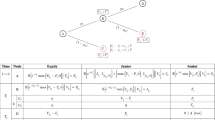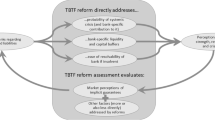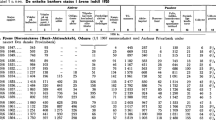Abstract
The high degree of concentration in the U.S. financial system has been intensified in the wake of the 2007–09 financial crisis. Implicit government support of banks that are deemed “too big to fail” has resulted in excessive risk taking and a focus on short-term rewards rather than long-term performance. This paper proposes a three-step plan to limit the federal safety net to commercial depository institutions and to restructure institutions so that no one institution poses systemic risk in the event of failure and that the largest banks face the same kind of risks of closure and market risk as the smallest.



Similar content being viewed by others
Notes
Moody’s estimates the credit uplift to be one or two notches as of March 27, 2013 [Financial Stability Oversight Council 2013].
Banks have also already found ways to sidestep many of the law’s provisions; for example, foreign banks are restructuring operations in the United States to avoid capital requirements [Enrich 2011] and some institutions are making use of “capital relief trades,” specialized credit default swaps that shift the risk associated with certain assets to another entity, fulfilling capital requirements while allowing the bank to keep those assets on its books [Craig 2013]. The use of lobbyists and funding of academic research by the industry’s trade associations, especially those that include the largest banking institutions, is on the rise [Solomon and others 2013].
The United States is not alone when it comes to large banking sectors. Many other nations have banking sectors that are even larger compared with their GDPs than that of the United States. For example, in 2010, the United Kingdom had total banking assets that were more than seven times its GDP, while Switzerland’s banking sector was 6.6 times the size of its GDP [Financial Stability Board 2012]. Taxpayers in both the United Kingdom and Switzerland still bear the burdens of supporting a few giant banking institutions that remain quasi-nationalized since the crisis [Colchester and Enrich 2013].
References
Atkinson, Tyler, David Luttrell, and Harvey Rosenblum . 2013. “How Bad Was It? The Costs and Consequences of the 2007–09 Financial Crisis,” Federal Reserve Bank of Dallas, Staff Papers, (July).
Bank for International Settlements. 2012. BIS Annual Report 2011/12, pp. 75–6.
Bloomberg View, 2013. “Why Should Taxpayers Give Big Banks $83 Billion a Year?” Bloomberg, (February 20).
Colchester, Max, and David Enrich . 2013. “Bank Bailout Blues Stall U.K. Recovery.” Wall Street Journal, (May 14) A1.
Craig, Susanne . 2013. “Seeking Relief, Banks Shift Risk to Murkier Corners.” New York Times, (April 10).
Enrich, David . 2011. “Banks Find Loophole on Capital Rule.” Wall Street Journal, (February 17).
Financial Stability Board, 2012. “Peer Review of Switzerland,” (January 25).
Financial Stability Oversight Council. 2013. 2013 Annual Report.
Fisher, Richard W ., and Harvey Rosenblum . 2013. “Vanquishing Too Big to Fail.” Federal Reserve Bank of Dallas, 2012 Annual Report.
Fraser Institute. 2012. Economic Freedom of the World: 2012 Annual Report.
Haldane, Andrew . 2012. “On Being the Right Size,” Speech at the 2012 Beesley Lectures, Institute of Economic Affairs, Bank of England, (October 25).
Kelleher, Dennis, Stephen Hall, and Katelynn Bradley . 2012. “The Cost of the Wall Street-Caused Financial Collapse and Ongoing Economic Crisis is More Than $12.8 Trillion,” report by Better Markets, Inc., (September 15).
Konczal, Mike . 2013. “Is It Already Time to Weaken Dodd-Frank?” The Washington Post, (March 23).
McCulley, Paul . 2009. “The Shadow Banking System and Hyman Minsky’s Economic Journey,” PIMCO, Insights: Global Central Bank Focus, (May).
Minsky, Hyman . 1992. “The Financial Instability Hypothesis,” Levy Economics Institute Working Paper no. 74, Bard College, (May).
Solomon, Deborah, Robin Sidel, and Aaron Lucchetti . 2013. “Big Banks Push Back Against Tighter Rules.” Wall Street Journal, (May 9) A1.
Ueda, Kenichi, and Beatrice Weder di Mauro . 2012. “Quantifying Structural Subsidy Values for Systemically Important Financial Institutions,” International Monetary Fund, Working Paper No. 12/128, (May 1).
U.S. Government Accountability Office, 2013. Financial Regulatory Reform: Financial Crisis Losses and Potential Impacts of the Dodd-Frank Act, Publication No. GAO-13-180, Jan.
Zibel, Alan, and Brent Kendall . 2013. “Holder: Banks May Be Too Large to Prosecute.” Wall Street Journal, (March 6).
Acknowledgements
The authors thank David Luttrell and Elizabeth Organ for excellent research assistance in writing this paper.
Additional information
The views expressed are those of the Federal Reserve Bank of Dallas and not necessarily those of others in the Federal Reserve System.
*Richard Fisher is President and CEO of the Federal Reserve Bank of Dallas, having assumed that post in April 2005. From 2001 to 2005, he served as Vice Chairman of Kissinger McLarty Associates, a strategic advisory firm. From 1997 to 2001, Fisher served as Deputy U.S. Trade Representative. Prior to that, Fisher created Fisher Capital Management, and a separate funds-management firm, Fisher Ewing Partners, managing both firms. He has also been a Special Assistant to the Secretary of the Treasury and worked at Brown Brothers, Harriman and Company. He holds a BA in economics from Harvard University, has studied Latin American Studies at Oxford, and holds an MBA from Stanford University.Harvey Rosenblum is Executive Vice President and Director of Research at the Federal Reserve Bank of Dallas. He is also a past president and member of the Executive Committee of the Board of Directors of NABE. He began his career with the Federal Reserve Bank of Chicago in 1970, becoming Vice President and Associate Director of Research in 1983. He joined the Dallas Federal Reserve as Senior Vice President and Director of Research in 1985 and was promoted to Executive Vice President in 2005. Rosenblum received a BA in economics from the University of Connecticut and a Ph.D. in economics from the University of California, Santa Barbara.
Rights and permissions
About this article
Cite this article
Fisher, R., Rosenblum, H. A Credible Path for Ending Too Big to Fail. Bus Econ 48, 167–173 (2013). https://doi.org/10.1057/be.2013.14
Published:
Issue Date:
DOI: https://doi.org/10.1057/be.2013.14




